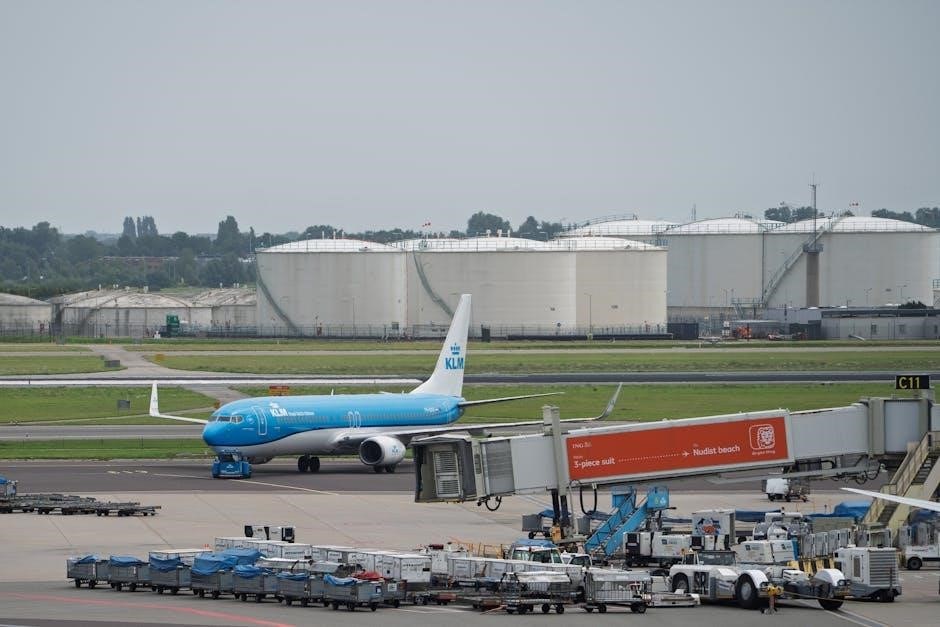provides foundational insights into aircraft and spacecraft design, emphasizing historical developments and modern innovations in aviation․
Basics of Aerospace Engineering
highlights foundational principles, including lift, drag, and thrust, essential for understanding flight mechanics․ The field combines physics, mathematics, and materials science to develop efficient and safe aerial vehicles, emphasizing both theoretical knowledge and practical applications․ Anderson’s work provides a comprehensive overview, making complex concepts accessible for students and enthusiasts alike․
Importance of Aerospace Engineering in Modern Aviation
underscores its role in developing innovative technologies, from fuel-efficient engines to advanced materials․ By addressing challenges like noise reduction and emissions, aerospace engineers contribute to sustainable air travel․ Anderson’s insights highlight how this field drives progress, enabling faster, greener, and more accessible flight solutions for global connectivity and exploration․
Aerodynamics Fundamentals
Aerodynamics explores how air interacts with moving objects, crucial for flight․ John D․ Anderson’s work explains foundational principles like lift, drag, and airflow, essential for aircraft design․

Basic Concepts of Aerodynamics
explains these principles, detailing how air pressure and flow influence an object’s motion․ Understanding these basics is crucial for designing efficient and safe aircraft, as outlined in Anderson’s comprehensive analysis of aerodynamic forces and their applications in aviation․
Lift and Drag Forces
explains how these forces are calculated and optimized․ Engineers design wings to maximize lift while minimizing drag, ensuring efficient flight․ These concepts are critical for understanding how aircraft achieve and sustain flight, as detailed in Anderson’s comprehensive analysis of aerodynamic principles and their practical applications in aviation engineering․
Applications of Aerodynamics in Aircraft Design
highlights how aerodynamic principles influence aircraft shape, reducing drag and enhancing lift․ This ensures better fuel efficiency and maneuverability․ Advances in computational fluid dynamics further refine designs, enabling modern aircraft to meet stringent performance and safety standards, as detailed in Anderson’s analysis of aerodynamic applications in aviation engineering․

Author Biography: John D․ Anderson, Jr․
John D․ Anderson, Jr․, born in 1937, is a renowned aerospace engineer and educator․ He earned a Bachelor of Aeronautical Engineering from the University of Florida in 1959․
Early Life and Education
John D․ Anderson, Jr․ was born on October 1, 1937, in Lancaster, Pennsylvania․ He pursued higher education at the University of Florida, graduating in 1959 with a Bachelor of Aeronautical Engineering degree, earning high honors․ His academic foundation in aerospace engineering laid the groundwork for his future contributions to the field, blending theoretical knowledge with practical applications that would later influence his renowned publications and teachings․
Career Highlights and Contributions to Aerospace
, which have become essential resources for aerospace engineering students․ His work has bridged historical developments with modern advancements, profoundly impacting the field of aerospace engineering and its educational landscape․
Publications and Academic Legacy
and Fundamentals of Computational Fluid Dynamics․ His works provide comprehensive insights into aerodynamics, aircraft design, and space flight dynamics․ Anderson’s publications have become essential resources for aerospace engineering students and professionals, blending theoretical concepts with practical applications․ His academic legacy continues to shape aerospace education, offering a foundational understanding of flight mechanics and modern advancements in the field․
Historical Context of Flight
The journey from early flight theories to powered aviation is explored, highlighting pioneers like the Wright Brothers and their impact on modern aerospace engineering․
Early Experimentation and Theories of Flight
highlights how these pioneers’ discoveries were refined over centuries, overcoming challenges in aerodynamic stability and control․
Wright Brothers and Their Contributions
details their systematic approach to aerodynamic experimentation, culminating in the Wright Flyer, which demonstrated controlled, sustained flight․ Their achievements marked a pivotal moment in aerospace engineering, inspiring future innovations in aircraft design and performance․
Evolution of Aeronautical Engineering
Aeronautical engineering evolved from early theoretical concepts to practical applications, driven by pioneers like the Wright Brothers and advancements in materials science․ The 20th century saw significant milestones, including all-metal aircraft, jet engines, and computational fluid dynamics․ John D․ Anderson’s work highlights how historical innovations, such as wing design and propulsion systems, laid the groundwork for modern aerospace technologies․ This continuous progression transformed aviation, enabling safer, faster, and more efficient flight capabilities that shape today’s global transportation and space exploration efforts․

Aircraft Design and Construction
Aircraft design integrates aerodynamics, structures, and propulsion systems to ensure efficiency and safety․ John D․ Anderson’s work emphasizes the importance of optimizing these elements for performance and durability․

Key Elements of Aircraft Design
Aircraft design focuses on optimizing weight, strength, and efficiency․ John D․ Anderson’s work highlights the importance of aerodynamic shapes, structural integrity, and propulsion systems․ Designers must balance performance, safety, and cost, ensuring compliance with aerospace standards․ Materials selection and systems integration are critical, with modern advances emphasizing fuel efficiency and sustainability․ Anderson’s insights provide a comprehensive understanding of these elements, guiding engineers in creating innovative and reliable aircraft․
Aerodynamic Considerations in Design
Aerodynamics plays a fundamental role in aircraft design, focusing on minimizing drag and maximizing lift․ John D․ Anderson’s work emphasizes understanding airflow behavior, airfoil shapes, and wing configurations․ Engineers must consider factors like Mach number, Reynolds number, and compressibility․ Computational tools, such as CFD, aid in optimizing designs for efficiency․ Anderson’s insights highlight the importance of aerodynamic stability and performance in creating reliable and efficient aircraft, ensuring safety and operational success across various flight conditions․
Modern Advances in Aircraft Design
Modern aircraft design integrates advanced materials like composites for lightweight strength and incorporates computational fluid dynamics (CFD) for aerodynamic optimization․ Adaptive structures enable real-time adjustments, improving performance․ Hybrid-electric propulsion systems enhance fuel efficiency and reduce emissions․ John D․ Anderson’s work highlights these innovations, emphasizing their role in next-generation aircraft․ These advancements ensure safer, more efficient, and environmentally friendly aviation solutions, shaping the future of aerospace engineering and flight technology․
Propulsion Systems
Propulsion systems, including turbojets and turbofans, drive aircraft efficiency․ Recent advances in hybrid-electric designs aim to reduce emissions and enhance performance, as detailed in Anderson’s work․
Types of Aircraft Engines
Aircraft engines include turbojets, turbofans, and piston engines․ Turbojets are used in military and high-speed aircraft, while turbofans combine efficiency with thrust, powering most commercial planes․ Piston engines, though less common, are still used in smaller, general aviation aircraft․ John D․ Anderson’s work details these engine types, explaining their thermodynamic principles and historical development, which are crucial for understanding modern aerospace engineering and propulsion systems․
Fuel Efficiency and Performance
discusses how engine design optimizations, such as bypass ratios and combustion efficiency, enhance performance while minimizing fuel consumption․ These advancements are vital for meeting the demands of sustainable aviation and ensuring future aircraft remain competitive in an eco-conscious industry․
Modern Developments in Propulsion Technology
Modern propulsion systems focus on enhancing efficiency, reducing emissions, and integrating advanced technologies․ Electric and hybrid-electric propulsion systems are emerging, offering potential for quieter and cleaner flight․ Advances in materials and engine design, such as ceramic matrix composites, improve thermal resistance and fuel efficiency․ John D․ Anderson’s work highlights the significance of these innovations in addressing future aviation challenges, ensuring sustainable and high-performance propulsion solutions for next-generation aircraft․

Flight Performance and Mechanics
Flight performance and mechanics involve understanding aerodynamics, propulsion, and dynamics of motion․ John D․ Anderson’s work provides foundational analysis of these key principles in modern aviation engineering․
Dynamics of Flight and Motion
The dynamics of flight and motion involve understanding the forces and movements that enable aircraft to operate effectively․ John D․ Anderson’s work explains the fundamental principles of aerodynamics, thrust, and weight distribution․ His analysis covers the historical development of flight theories and their modern applications․ The text highlights how these principles are crucial for optimizing aircraft performance and ensuring safe, efficient flight operations․ Anderson’s insights are invaluable for both students and professionals in aerospace engineering, providing a comprehensive understanding of flight mechanics․
Performance Analysis and Optimization
John D․ Anderson’s work emphasizes the importance of performance analysis in aerospace engineering, focusing on aerodynamic efficiency, engine performance, and weight distribution․ His insights highlight how understanding these factors enables the optimization of aircraft design․ By analyzing historical and modern approaches, Anderson provides a framework for improving flight performance, ensuring safer and more efficient aviation systems․ His work is a cornerstone for students and professionals seeking to advance aerospace engineering through data-driven design and operational improvements․

Stability and Control
Stability and control are critical in aerospace engineering, ensuring aircraft equilibrium during flight․ Anderson discusses aerodynamic principles, such as pitch, roll, and yaw, and their impact on maneuverability and safety․
Aerodynamic Stability in Flight
Aerodynamic stability ensures an aircraft’s ability to maintain equilibrium during flight, resisting disturbances like turbulence․ Anderson explains how lift, drag, thrust, and weight interact to achieve stability, emphasizing the role of wing design and tail surfaces in maintaining control․ The center of pressure and center of gravity are critical factors, influencing pitch, roll, and yaw․ Understanding these principles is vital for designing aircraft that remain stable under various flight conditions, ensuring safety and performance․
Anderson’s work highlights historical advancements in stability, such as the Wright Brothers’ innovations, and modern computational tools that refine aerodynamic designs․ His insights provide a comprehensive foundation for engineers to develop stable and efficient aircraft systems, balancing aerodynamic forces for optimal flight performance․
Control Systems and Their Functions
Control systems in aircraft are essential for maintaining stability and maneuverability during flight․ Anderson explains how primary flight controls, such as ailerons, elevators, and rudder, govern roll, pitch, and yaw․ These systems enable precise control over the aircraft’s orientation and movement, ensuring safe and efficient flight operations․
Modern aircraft employ advanced control systems, including fly-by-wire technology, which enhances precision and reduces pilot workload․ Anderson’s work highlights the integration of mechanical and hydraulic systems with electronic controls, optimizing performance and safety․ These systems are critical for navigating various flight conditions and ensuring passenger safety․

Materials and Structures in Aerospace
Aerospace engineering relies on lightweight, high-strength materials like aluminum alloys and advanced composites․ Anderson discusses their role in optimizing aircraft performance, safety, and fuel efficiency․
Materials Used in Aircraft Construction
Aircraft construction utilizes lightweight, high-strength materials like aluminum alloys, titanium, and advanced composites․ These materials are chosen for their exceptional strength-to-weight ratio, corrosion resistance, and thermal stability․ Aluminum alloys are widely used in airframes due to their durability and cost-effectiveness, while titanium is preferred for high-temperature applications like engines․ Composite materials, such as carbon fiber reinforced polymers, are increasingly popular for reducing weight and enhancing structural integrity․ These materials are critical for optimizing aircraft performance, fuel efficiency, and safety․
- Aluminum alloys for airframes
- Titanium for high-temperature components
- Composites for weight reduction and strength
Structural Integrity and Safety
Structural integrity ensures aircraft withstand operational stresses, while safety protocols prevent failures․ Rigorous testing, including stress analysis and fatigue testing, validates design durability․ Materials like aluminum and composites are selected for strength and reliability․ Safety certifications and regulations enforce strict standards․ John D․ Anderson emphasizes the importance of structural analysis in maintaining flight safety․ These practices minimize risks, ensuring reliable and secure aircraft operation․ Advances in materials and testing have significantly enhanced aerospace safety standards․
- Stress and fatigue testing
- Safety certifications
- Advanced materials

Space Flight and Its Challenges
Space flight faces extreme temperatures, radiation, and propulsion demands․ John D․ Anderson’s work highlights challenges like hypersonic flows and high-temperature gas dynamics, crucial for spacecraft design and safety․

- Extreme environmental conditions
- Propulsion system efficiency
- Materials resilience
Space flight dynamics involves understanding the motion of spacecraft under gravitational and propulsion forces․ John D․ Anderson’s work highlights the principles of orbital mechanics and trajectory design․ His research explores hypersonic flows and high-temperature gas dynamics, essential for spacecraft re-entry․ Anderson’s textbooks provide a foundational understanding of space flight, covering topics like rocket propulsion and the challenges of operating in extreme environments․ His insights have significantly influenced the development of modern aerospace engineering and space exploration technologies․
Challenges in Space Exploration
Space exploration faces significant challenges, including extreme temperatures, radiation exposure, and the psychological effects of long-duration missions․ Overcoming these requires advanced propulsion systems and materials capable of withstanding harsh conditions․ John D․ Anderson’s research highlights the importance of efficient fuel systems and lightweight structures for deep-space travel․ Additionally, navigating gravitational forces and ensuring precise trajectory control are critical for mission success․ Addressing these challenges is essential for advancing human presence in space and achieving sustainable exploration of celestial bodies․
Applications of Space Flight Technology
Space flight technology has revolutionized global communication, weather forecasting, and navigation through satellites․ GPS systems, enabled by space-based infrastructure, are integral to transportation and logistics․ Remote sensing technologies monitor environmental changes and agricultural health․ Medical advancements, inspired by space research, improve healthcare․ Additionally, materials developed for space exploration, like memory foam and LED lights, enhance everyday life․ These applications highlight the profound impact of space flight technology on Earth, demonstrating its versatility and importance in driving innovation across industries․
Computational Fluid Dynamics (CFD)
CFD is a computational tool simulating fluid flow and heat transfer, aiding in aircraft and spacecraft design․ It enhances aerodynamic performance and propulsion efficiency, as outlined in Anderson’s works․
Role of CFD in Aerospace Engineering
Computational Fluid Dynamics (CFD) is a critical tool in aerospace engineering, enabling the simulation of fluid flow and heat transfer․ It aids in optimizing aircraft and spacecraft designs by analyzing aerodynamic performance, reducing drag, and enhancing propulsion efficiency․ CFD also supports the study of complex phenomena like turbulence and supersonic flows․ As discussed in John D․ Anderson’s works, CFD has revolutionized the field by providing precise, cost-effective solutions for improving flight performance and safety․
Applications of CFD in Aircraft Design
highlights CFD’s role in streamlining designs, ensuring stability, and enhancing fuel efficiency․ By providing accurate simulations, CFD accelerates the development of safer, more efficient, and high-performance aircraft, making it indispensable in modern aerospace engineering․
provides a comprehensive overview of aerospace engineering, blending historical insights with modern advancements․ The book serves as a valuable resource for students and professionals, offering a clear understanding of aerodynamics, propulsion, and design principles․
by John D․ Anderson Jr․ covers foundational aerospace engineering principles, including aerodynamics, propulsion, and aircraft design․ It explores historical developments, such as the Wright Brothers’ contributions, and modern advancements in computational fluid dynamics․ The book emphasizes the interplay between theoretical concepts and practical applications, providing insights into materials science, structural integrity, and performance optimization․ Anderson’s work serves as a comprehensive guide for understanding the evolution and future of aerospace engineering․
Future of Aerospace Engineering
The future of aerospace engineering lies in advancing technologies like electric propulsion, hypersonic flight, and reusable spacecraft․ Innovations in materials science and computational fluid dynamics will drive efficiency and performance․ Sustainability will play a crucial role, with eco-friendly fuels and designs․ AI and machine learning will enhance design optimization and safety․ Space exploration will expand, with private-sector contributions accelerating progress․ John D․ Anderson’s work highlights these trends, emphasizing the need for interdisciplinary collaboration to meet future challenges and opportunities in aerospace engineering․
